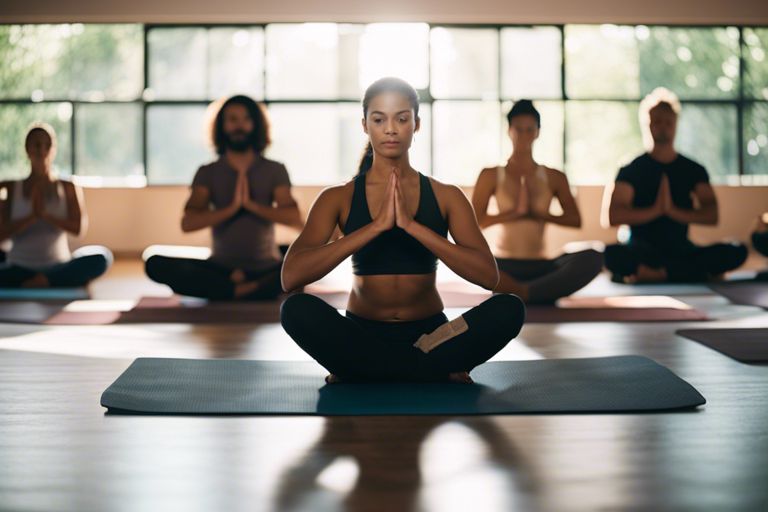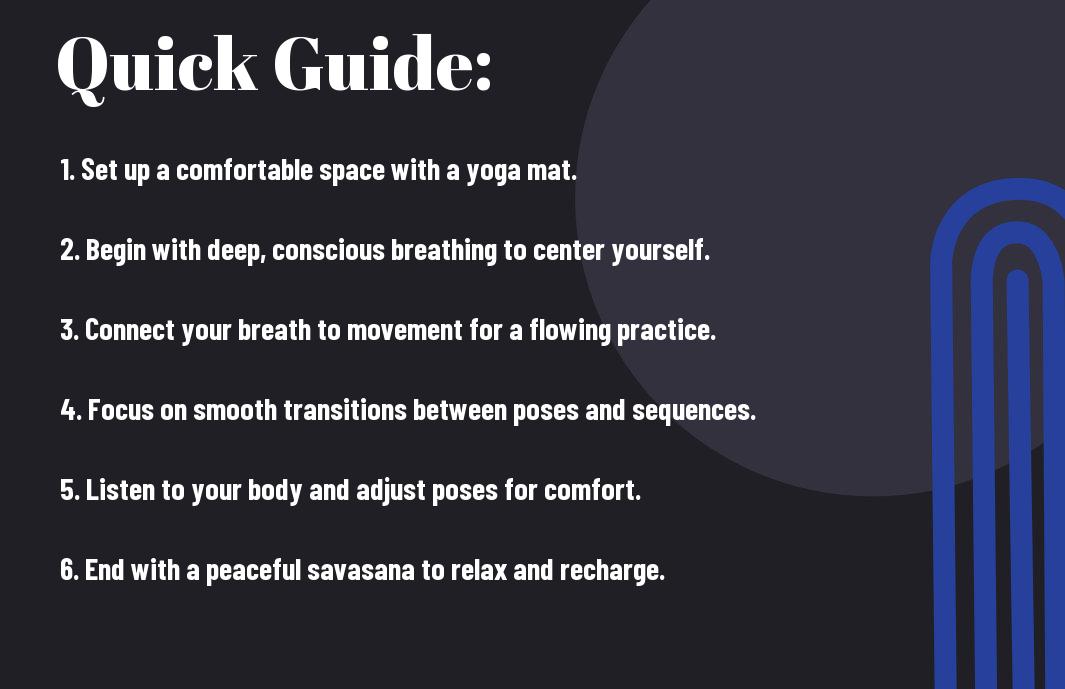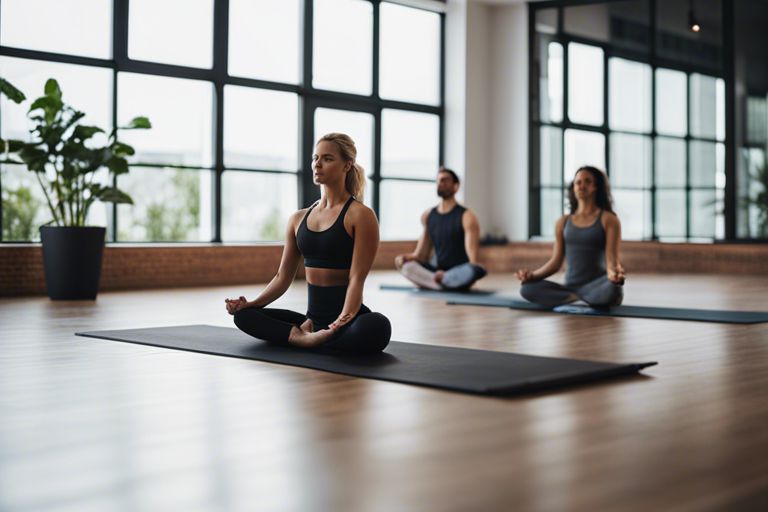Harmony between breath and movement is the essence of Vinyasa yoga, a dynamic practice that synchronizes poses with inhalations and exhalations. This ultimate guide will explore into the benefits of Vinyasa, the importance of proper breathing techniques, and how to achieve a flowing sequence with grace and ease. Discover how Vinyasa yoga can help you build strength, improve flexibility, and cultivate a sense of inner peace through the fusion of breath, movement, and harmony. It’s time to enhance your practice and connect your mind, body, and spirit on the mat. Namaste.

Key Takeaways:
- Vinyasa Yoga Integration: Focuses on the synchronization of breath and movement in a seamless flow.
- Breath Awareness: Emphasizes the importance of using the breath as a tool to guide the practice and deepen the connection between mind and body.
- Harmony and Balance: Strives to achieve harmony and balance through the practice, creating a sense of calm and peace within the practitioner.
 Before exploring into the practice of Vinyasa Yoga, it is crucial to have a solid understanding of what this dynamic practice entails. Vinyasa Yoga is a popular style of yoga that synchronizes breath with movement. The word “Vinyasa” translates to “arranging something in a special way,” emphasizing the fluid transition between poses in a sequence. This style of yoga focuses on linking breath to movement, creating a dance-like flow that challenges the body, builds strength, and improves flexibility.
Before exploring into the practice of Vinyasa Yoga, it is crucial to have a solid understanding of what this dynamic practice entails. Vinyasa Yoga is a popular style of yoga that synchronizes breath with movement. The word “Vinyasa” translates to “arranging something in a special way,” emphasizing the fluid transition between poses in a sequence. This style of yoga focuses on linking breath to movement, creating a dance-like flow that challenges the body, builds strength, and improves flexibility.
Definition and History
Yoga has its roots in ancient Indian philosophy and has evolved over thousands of years. Vinyasa Yoga, also known as Vinyasa Flow, gained popularity in the late 20th century, thanks to influential teachers like Pattabhi Jois and Shiva Rea. This style of yoga is characterized by its smooth, continuous flow of poses, where each movement is linked to either an inhale or an exhale.
Principles and Philosophy
The Principles and Philosophy of Vinyasa Yoga are deeply rooted in the traditional Eight Limbs of Yoga as outlined by the sage Patanjali. The practice emphasizes the importance of breath control (pranayama), concentration (dharana), and meditation (dhyana) to cultivate a state of inner peace and mindfulness. Vinyasa Yoga encourages practitioners to stay present in the moment, connecting mind, body, and breath.
Definition: Vinyasa Yoga is a dynamic style of yoga that focuses on the seamless flow between poses, synchronized with breath. The practice embodies a sense of fluidity, strength, and mindfulness, making it a popular choice for yogis looking to deepen their practice.
Types of Vinyasa Yoga
You can explore various types of Vinyasa Yoga that cater to different preferences and fitness levels. Here is a breakdown of some popular styles:
| Hatha Vinyasa | Ashtanga Vinyasa |
| Power Vinyasa | Yin Vinyasa |
On Hatha Vinyasa
Hatha Vinyasa is a gentle and foundational style that focuses on basic postures and alignment. This type of yoga integrates breathing with each movement, promoting a sense of balance and mindfulness throughout the practice.
While Ashtanga Vinyasa
Ashtanga Vinyasa is a more dynamic and physically demanding style that follows a specific sequence of poses. This practice focuses on strength, flexibility, and stamina through synchronized breath and movement. It is an excellent choice for those looking for a challenging and structured practice.
Plus, Ashtanga Vinyasa incorporates Ujjayi breathing and Bandhas (energy locks) to enhance the flow of energy in the body, resulting in a powerful and meditative experience.
Power Vinyasa
Power Vinyasa is a vigorous and fast-paced style that helps build strength, endurance, and heat in the body. This dynamic practice focuses on flowing sequences that challenge both the body and mind, making it ideal for those seeking a high-intensity workout on the mat.
Power Vinyasa classes often incorporate core exercises, arm balances, and inversions to elevate the practice and bring a sense of empowerment to the yogi.
Ashtanga Yin Vinyasa
Now, Yin Vinyasa is a gentle and restorative style that combines the fluidity of Vinyasa with the deep stretching of Yin Yoga. This practice focuses on holding poses for an extended period to target the connective tissues and promote flexibility and relaxation in the body.
To research deeper into the practice, practitioners can expect long holds in postures such as pigeon pose and supported backbends, allowing for a meditative and introspective experience on the mat.
Preparing for Your Practice
Despite the seemingly simple nature of Vinyasa yoga, preparing for your practice requires careful consideration of vital elements that can enhance your experience and progress in the practice. From selecting the right equipment and props to creating a conducive environment and setting realistic goals, these steps are crucial in ensuring a fulfilling Vinyasa yoga practice.
Essential Equipment and Props
With proper equipment and props, you can significantly elevate your Vinyasa yoga practice. A high-quality yoga mat with good cushioning and grip is vital for ensuring stability and comfort during poses and transitions. Additionally, props such as blocks, straps, and blankets can be used to support your practice, assist in alignment, and provide modifications for different poses.
Creating a Conducive Environment
Assuming a conducive environment is crucial for a focused and enriching Vinyasa yoga practice. Choose a quiet, clutter-free space with adequate ventilation and natural light. You can enhance the ambiance with soft lighting, calming music, or vital oils to create a soothing atmosphere that promotes relaxation and concentration.
Plus, consider incorporating elements like plants, inspirational quotes, or personal items that resonate with you to personalize your practice space and make it more inviting and motivational.
Setting Realistic Goals and Expectations
Setting realistic goals and expectations for your Vinyasa yoga practice is vital for progress and consistency. Props like yoga blocks and straps can be excellent tools for beginners looking to improve flexibility and strength gradually. Remember that progress in yoga is a journey, and it’s vital to be patient and compassionate with yourself along the way.
Equipment such as a reliable yoga mat, supportive blocks, and comfortable clothing can make a significant difference in your practice. Investing in high-quality equipment will not only enhance your comfort but also prevent injuries and support your alignment throughout your practice.
Step-by-Step Guide to a Vinyasa Yoga Practice
| Breathing Techniques and Pranayama | Foundational Postures and Transitions |
TechniquesNot just about the physical postures, Vinyasa yoga places a strong emphasis on linking breath with movement. Practicing various breathing techniques, or pranayama, such as Ujjayi breath (ocean breath) can help enhance your practice and focus the mind. |
Foundational Postures and TransitionsAn integral part of Vinyasa yoga is the flow between postures, also known as transitions. Each posture is typically connected with a specific breath, creating a seamless movement sequence. |
For instance, as you move from Downward Facing Dog to Plank pose, you would inhale to transition, and as you move from Plank to Chaturanga, you would exhale, maintaining fluidity and control throughout.
Building a Balanced Sequence
Building a well-rounded Vinyasa yoga sequence involves incorporating a variety of postures that target different areas of the body. This helps to create balance, flexibility, and strength throughout your practice.
Building a sequence can also involve adding dynamic movements like Sun Salutations to warm up the body, followed by standing postures, seated postures, backbends, twists, and inversions to create a comprehensive practice.
Common Mistakes to Avoid
Breathing incorrectly or holding your breath during transitions can disrupt the flow of energy in your practice and lead to decreased focus and stability. Remember to keep a steady and conscious breath throughout your practice.
It is also important to avoid forcing yourself into deep stretches or advanced postures before your body is ready. Listen to your body and gradually work towards challenging poses to prevent injury and promote progress in your practice.
Tips for Enhancing Your Practice
Your Vinyasa yoga practice can be taken to the next level by incorporating a few key tips and techniques. Here are some suggestions to enhance your experience:
Focus on Alignment and Body Awareness
With Vinyasa yoga, paying attention to alignment and body awareness is crucial. Focus on keeping your body in the correct positions during each pose to avoid injury and get the maximum benefit from the practice. Assume that each movement has a purpose and take the time to feel how your body responds to it.
Cultivating Mindfulness and Meditation
To deepen your practice, cultivate mindfulness and incorporate meditation into your routine. Be present in the moment, focus on your breath, and quiet the mind to gain mental clarity and emotional balance. Assume that by incorporating mindfulness and meditation, you can enrich your overall yoga experience.
Using Music and Mantras to Enhance Your Experience
Your practice can be elevated by incorporating music and mantras into your routine. Choose calming music and powerful mantras that resonate with you to create a harmonious atmosphere during your practice. Using sounds can help you focus, relax, and connect more deeply with your inner self.
Practicing Yoga with Injuries or Modifications
The practice of yoga can be modified to accommodate injuries or physical limitations. Mantras such as “listen to your body” and “honor where you are today” can guide you to make necessary adjustments to your practice. Assume that by practicing safely and mindfully, you can still experience the benefits of Vinyasa yoga while allowing your body to heal and strengthen.
Factors to Consider for a Safe and Effective Practice
- Keep breath, movement, and harmony in mind during your practice.
- Ensure you listen to your body’s cues and avoid pushing yourself too far.
- Remember that consistency and patience are key to progress in Vinyasa Yoga.
Physical Limitations and Health Conditions
On your Vinyasa Yoga journey, it is crucial to be aware of any physical limitations or health conditions you may have. Consult with your healthcare provider before starting any new exercise regimen to ensure your safety and well-being. It is crucial to modify poses or avoid certain sequences if they exacerbate any existing conditions.
The Mastering the Art of Vinyasa: Yoga Tips for Beginners article offers valuable insights for beginners on practicing Vinyasa Yoga safely.
Mental and Emotional Well-being
There’s more to Vinyasa Yoga than just the physical aspect. It can also greatly benefit your mental and emotional well-being. Through the combination of breath and movement, Vinyasa Yoga can help reduce stress, anxiety, and improve mental clarity. The practice fosters a sense of peace and balance within.
Nutrition and Lifestyle Choices
With Vinyasa Yoga, it’s crucial to pay attention to your nutrition and lifestyle choices. Fueling your body with nutrient-dense foods and maintaining healthy habits outside of your practice can enhance your overall well-being. Hydration, rest, and a balanced diet play a crucial role in supporting your practice.
Finding a Qualified Teacher or Mentor
Even with a consistent practice, it is crucial to have the guidance of a qualified teacher or mentor in Vinyasa Yoga. A knowledgeable instructor can provide feedback, correct alignment, and offer support as you progress in your practice. Their expertise can help you navigate any challenges and deepen your understanding of Vinyasa Yoga.
Pros and Cons of Vinyasa Yoga
All yoga practices have their own sets of advantages and disadvantages, and Vinyasa yoga is no exception. Let’s explore the pros and cons of this dynamic and flowing style of yoga.
| Pros | Cons |
| Improves flexibility and strength | Potential for overexertion and injury |
| Enhances focus and concentration | Can be challenging for beginners |
| Boosts cardiovascular health | May not be suitable for individuals with certain injuries |
| Encourages mindfulness and stress relief | Requires a certain level of fitness |
| Helps in weight management | Fast-paced nature may not suit everyone |
Physical and Mental Benefits
The Flowing with Vinyasa: The Next Step on Your Fitness … article highlights how Vinyasa yoga can offer a range of physical and mental benefits. This practice not only improves physical fitness through movements and postures but also enhances mental well-being by promoting mindfulness and reducing stress.
Potential Drawbacks and Challenges
Physical fitness aside, it’s crucial to acknowledge the potential drawbacks and challenges that come with Vinyasa yoga. While the practice can be highly rewarding, it’s important to be aware of the physical demands it poses. Participants may encounter challenges such as overexertion or injury due to the fast-paced and strenuous nature of Vinyasa flows.
Making Vinyasa Yoga a Sustainable Lifestyle Choice
To truly integrate Vinyasa yoga into your lifestyle as a sustainable choice, it’s important to approach the practice mindfully and with awareness. Consistency and listening to your body are key factors in making Vinyasa yoga a sustainable part of your routine. Embracing modifications and honoring your body’s limitations can help prevent potential injuries and burnout.
Conclusion
Upon reflecting on The Ultimate Guide To Practicing Vinyasa Yoga – Breath, Movement, And Harmony, it is clear that this ancient practice offers a pathway to physical, mental, and emotional well-being. By focusing on the breath, synchronizing movement, and finding harmony within ourselves, we can experience the transformative power of Vinyasa yoga in our daily lives.
Remember that practicing Vinyasa yoga is a journey, not a destination. It requires dedication, patience, and self-awareness. By cultivating these qualities and embracing the principles of breath, movement, and harmony, we can tap into our inner strength, find balance, and ultimately connect with our true selves on and off the mat.
FAQ
Q: What is Vinyasa Yoga?
A: Vinyasa Yoga is a dynamic style of yoga that synchronizes breath with movement. It is often referred to as “flow” yoga because of the smooth way the poses run together like a dance.
Q: What are the benefits of practicing Vinyasa Yoga?
A: Practicing Vinyasa Yoga can help improve flexibility, strength, and balance. It also focuses on mindfulness and breath awareness, which can help reduce stress and increase mental clarity.
How can I create a Vinyasa Yoga practice at home?
A: To create a Vinyasa Yoga practice at home, you can start by setting aside a designated space, choosing a sequence of poses that work for you, and focusing on linking your breath with your movements. There are many online resources and videos available to guide you through a home practice.











